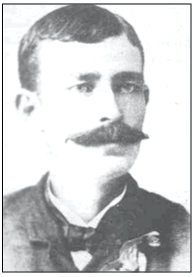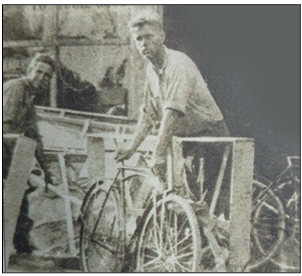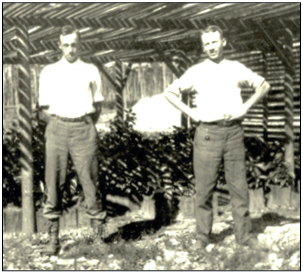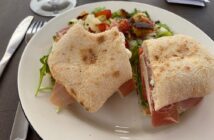Presented by the South Miami Historic Board. (Published 2012)
Discover the historic buildings of South Miami’ s Town Center as you enjoy a leisurely
walk along Sunset Drive.
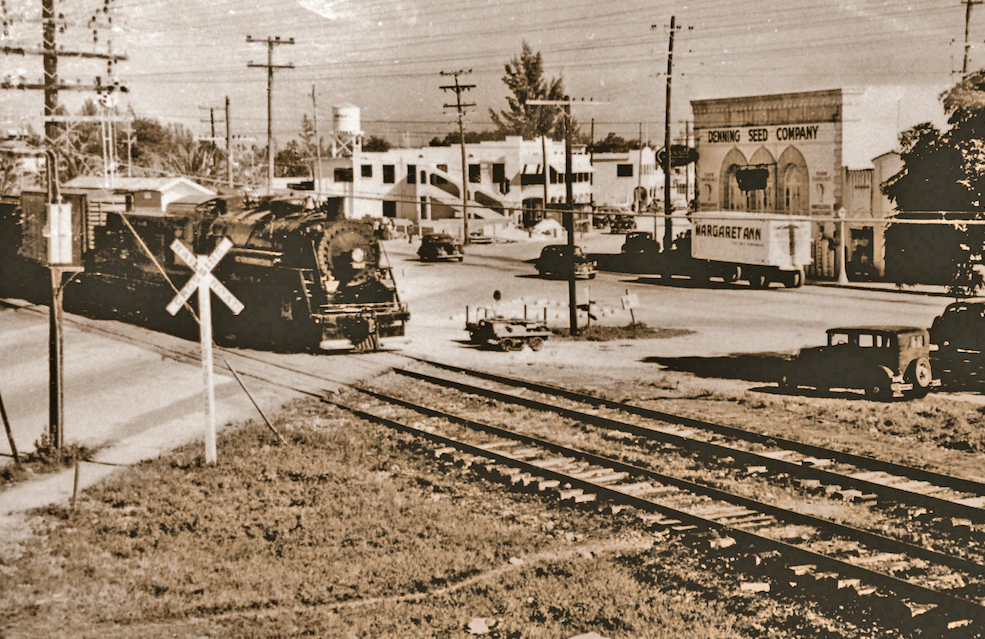
Watching the endless swarm of traffic moving along Dixie Highway, it is difficult to imagine that South Miami began as an outpost accessed by unpaid trails. This little Town of Larkins developed here in 1899, eventually grew into the City of South Miami by 1927, thanks to the arrival of Flagler’s Florida East Coast Railway (FEC). The railway provided a sophisticated link to expanding markets for the local homesteaders, farmers and lumbermen, and ensured their prosperity. A fixture in the downtown for over 50 years, the railway tracks once ran on about the same trajectory as today’s Metrorail.
Pioneering families, such as Dorn, Opshal, Shelley, Dowling, and Williamson settled here from the end of the nineteenth century to the early decades of the twentieth, helping to establish a community. One pioneer, Wilson Alexander Larkins (1860-1946), the towns’ namesake, settled east of presented by downtown in Cocoplum Circle in 1897. Eventually, he owned scores of acres of farmland, operated a small dairy (taking milk to Miami in a specially designed tanks fitted to his bicycle), the post office, a general store, and later a commissary, packing house, and siding with station near the FEC tracks.
With the coming of the railway, the center of the small settlement shifted westerly, growing into a city.
Today’s South Miami’s downtown streetscape sports a mix of architectural styles, among them, historically designated buildings dated from 1914 to 1955. They serve to bookend two major periods of construction activity, the feverish days of the newly “discovered” 1920’s era South Florida and the Post World War II boom.
1. DORN-MARTIN DRUGSTORE: 5900 Sunset Drive – Built: 1925
Architect: Robert Dorn (Attributed) / Style: Mission
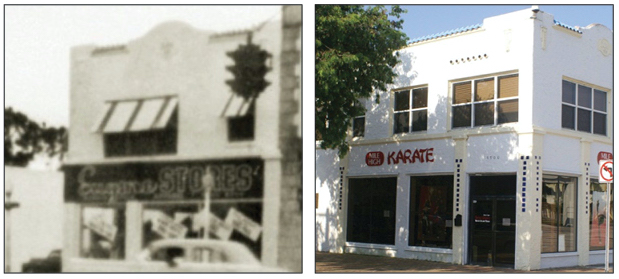
The first in a series of three buildings on this site erected by brothers Robert and Harold Dorn, the Drugstore, like the Bank building and the Post Office, is a survivor from the Florida building boom days of the 1920s. Fronting directly on Sunset Drive, the two-story structure exhibits all the hallmarks of the Mission style. Of note is the curvilinear central parapet, the broad expanses of stucco, the use of barrel tile coping at the parapet, the engaged plasters that separate the windows and entry bays, and the decorative glazed ceramic tile accents.
The front entrance, now squared-off, was originally in the form of an arch.
2. BANK BUILDING: 5910 Sunset Drive – Built: 1926
Architect: Robert Dorn (Attributed) Style: Neoclassical (Derivative)
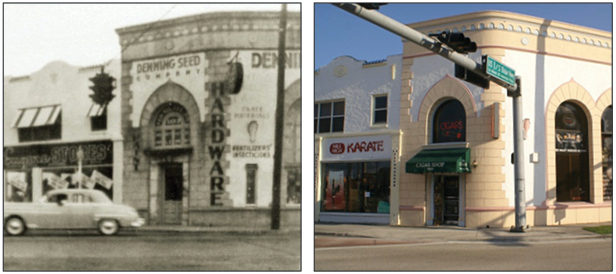
Part of a series of buildings constructed by the Dorn Brothers, the Bank building was originally designed to host the South Florida Bank. However, this site was never home to any bank. It has been used throughout time as retail space. The two-story building wraps around the corner of Sunset Drive and is remarkable for its façade with triple arched openings, alternating large and small blocks of stone, cast relief medallions, all topped by a weighty cornice. One major change was the removal of the mullions from the original widows.
3. SOUTH MIAMI POST OFFICE: 5904 Sunset Drive – Built: 1926
Architect: Robert Dorn (Attributed) / Style: Mediterranean Revival
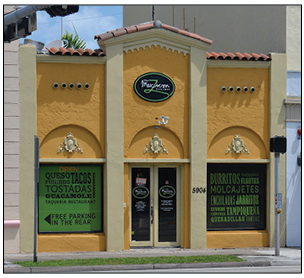
One of South Miami’s post offices, this building fronts only 25 feet of space along US 1. Best described as Mediterranean Revival, the one-story building achieves a strict symmetry as it is divided into a center bay that terminates above the roof line in a pediment form and is flanked by two bays of equal dimensions that feature blind, rounded arches above the square storefront windows. Original windows have been replaced by modern float glass. Through time the building has served a variety of retail purposes. (Historic photo unavailable)
4. COMMERCIAL BUILDING: 5893 SW Sunset Drive – Built: 1948
Architect/Builder: E.J. Newby / Style: Streamline Moderne (Derivative)
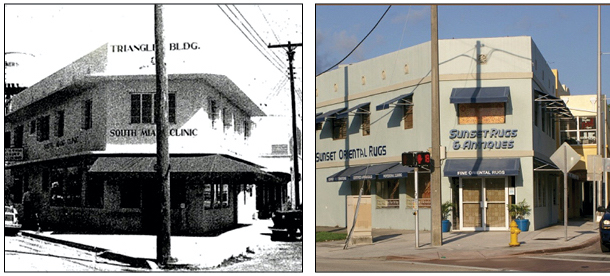
Built during the Post World War II boom, this tidy little building literally had to be wedged into a 57.6 x 70-foot space. Originally the building had two prominent slabs of concrete that ran completely around the structure shading the windows on the first and second floors. These “eyebrows” were reminiscent of an architectural style that was popular in the 1930s. At some point in the life of the building the brows were removed and replaced with stucco banding. The combination of this building with the Dorn structures directly across Sunset Drive serve to announce the eastern entrance to South Miami’s downtown retail center.
5. DOWLING BUILDING: 5875 Sunset Drive – Built: 1914-1926
Architect/Builder: Unknown / Style: Commercial Masonry Vernacular
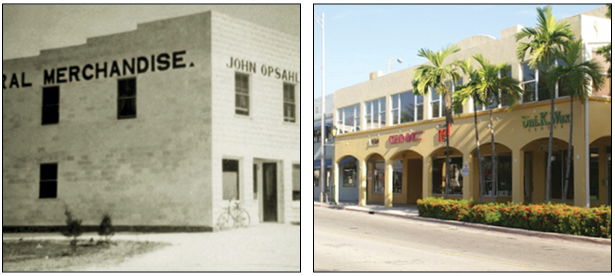
This structure has as its core one of the oldest surviving concrete block buildings in the city. Originally built in 1914 as a general store for pioneer John Opsahl, it was transformed by William Manning Dowling in 1926. Opsahl’s utilitarian design was enriched by the addition of a number of architectural elements. The new affair added and arcade, a curved and crenellated front parapet, and a screened porch above the arcade. Dowling added apartments to the second floor, maintaining retail on the first. In 1994 significant changes included the addition of windows to the porch, apartments made into offices, crenellations removed and the arches reshaped.
6. SHELLEY BUILDING: 5837 Sunset Drive – Built: 1926
Architect: Robert Shelley / Style: Mediterranean Revival/Mission
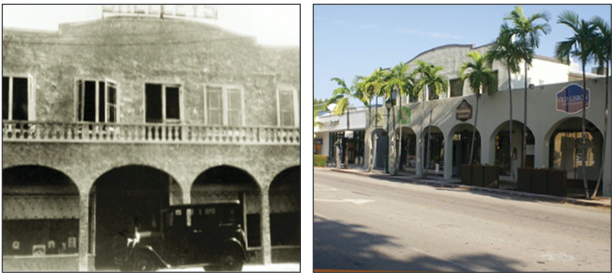
The Shelley Building was another product of the building boom underway in the 1920-era Town of Larkins. The Shelley family arrived in the area in 1911 when George Shelley purchased five acres of land from a Flagler subsidiary. Originally a one-story retail structure, Robert Shelley (son of George) later added a second floor with four apartment and the front arcade. Today the building is minus the lovely balustrade that once graced the top of the arcade, the windows on the storefronts and second floor are not original.
7. D.J. RED BUILDING: 5850 Sunset Drive – Built: 1923
Architect/Builder: Unknown / Style: Mediterranean Revival
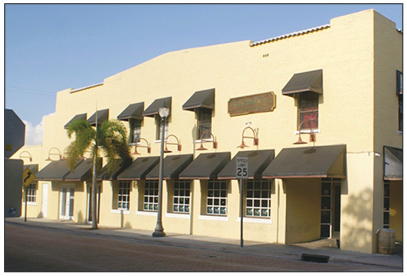
The D.J. Red family arrived in Larkins in 1914. D.J. Red served as City Commissioner and City Clerk. Designed to accommodate living quarters on the second floor and retail shops the first, another building section was added by son Jesse Red In the 1940s which extended the structure along SW 58th Court. The newer addition once served as an automotive shop. The Red building often housed popular restaurants including the Waffle Shop in the 1960s and JJ’s American Diner in the 1980s (Historic photo unavailable)
8. 5800 SUNSET DRIVE – Built: 1929
Architect/Builder: Unknown / Style: Mediterranean Revival
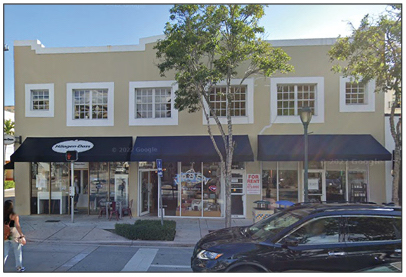
This building expresses the elements of the Mediterranean Revival style in its masonry construction, the regularly spaced windows, and the prominent parapet that peaks in a triangular pediment in the center, extending higher at the ends of the building on both north and south sides. The ornamentation is concentrated around the windows and the primary elevation which a pronounced band of stucco in relief. There have been alterations over time however the original character of the building prevails. The building was designed to accommodate residences on the second floor and retail on the first. (Historic photo unavailable)
9. CROSSROADS BUILDING: 5700 Sunset Drive – Built: 1955
Architect: M. Tony Sherman / Style: Mid-Century Modern
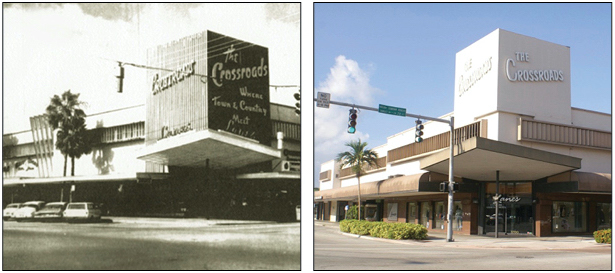
Built as a shopping center “Where Town and Country Meet,” this structure holds a distinctive place in the streetscape, announcing the western entrance to the city’s downtown retail district. Now missing are the slat cladding on the central tower and a set of oversize vertical “fins” from the eastern elevation. Designed with ground floor shops and second floor offices, it enjoyed the luxury of air-conditioning. The Crossroads continues to host a variety of shops including Lanes, which has been selling clothing in this location since the building first opened.
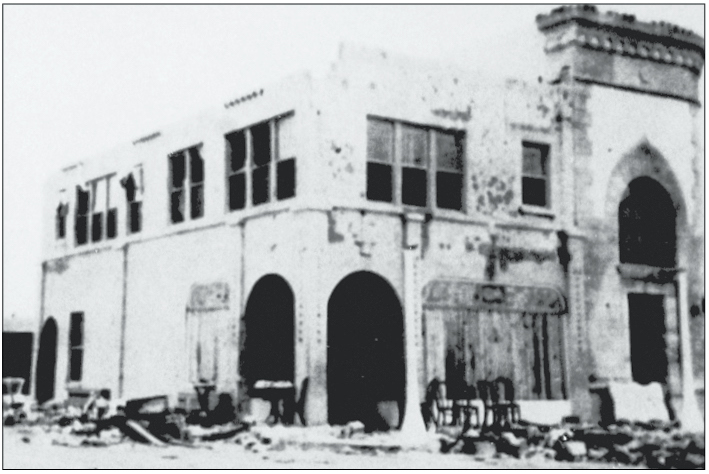
The GREAT MIAMI HURRICANE OF 1926 in September was a large and intense tropical cyclone that devastated the Greater Miami area and caused catastrophic damage in the Bahamas and the U.S. Gulf Coast accruing a US$100 million damage toll. As a result of the devastation wrought by the hurricane in Florida, the Land Boom in Florida ended.
Pictured here is the devastation to the newly constructed Dorn Brothers bank building.
The University of Miami had been founded in 1925 and opened its doors for the first time just days after the hurricane passed. The university’s athletic teams ere nicknamed the Hurricanes in memory of this catastrophe. The school’s mascot is Sebastian, an ibis. The ibis is a small white bird that can be seen around South Florida, including on the UM campus. According to folklore, the ibis is the last bird to leave before a hurricane strikes and the first to return after the storm, hence its selection for the school mascot.

